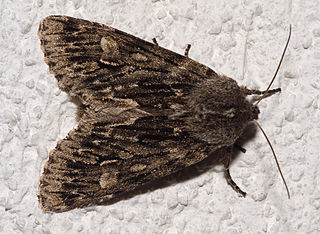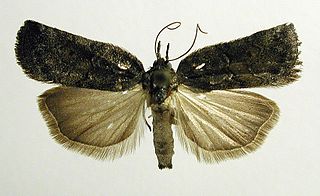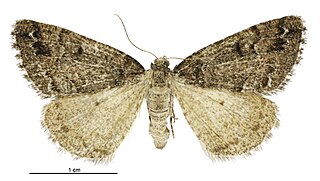
Brachionycha nubeculosa, the Rannoch sprawler, is a moth of the family Noctuoidea. It is found across the Palearctic from the British Isles in the west, across central and northern Europe over Russia, Siberia to China. The species is only locally distributed in central Europe, but is often relatively common in this region. In southern Europe, the occurrence is limited to some mountainous regions. In Germany, it reaches as far as the summit regions of the low mountain ranges. The species is moisture loving and prefers moist, cool temperate forests, mixed forests, wooded valleys, river and stream edges as well as orchards.

Ptycholoma lecheana, the Leche's twist moth, is a moth of the family Tortricidae. It is found in Europe, China, Korea, Japan, Russia and Asia Minor.

The March dagger moth is a moth of the subfamily Chimabachinae. It is found in Europe and was first described by Michael Denis & Ignaz Schiffermüller in 1775.

Agonopterix arenella is a species of moth of the family Depressariidae. It is found in all of Europe, except the Iberian Peninsula.

Catocala electa, the rosy underwing, is a moth of the family Erebidae. The species was first described by Karl Friedrich Vieweg in 1790. It can be found in Europe and Asia.

Anacampsis populella is a moth of the family Gelechiidae, which is native to Europe and has been accidentally introduced to North America. It was first described in 1759 by Carl Alexander Clerck, a Swedish entomologist. The type specimen is from Sweden. The foodplants of the larvae are poplars and willows.

Agrotis vestigialis, the archer's dart, is a moth of the family Noctuidae. The species was first described by Johann Siegfried Hufnagel in 1766. It is found in most of the Palearctic realm from Ireland east, through to Russia, Siberia, the Altai Mountains and the Amur region, and is also present in the Mediterranean Basin. It is absent from the north of Finland and Norway.

Agrotis trux, the crescent dart, is a moth of the family Noctuidae. The species was first described by Jacob Hübner in 1824. It has a circum-Mediterranean distribution and is found along the coasts of France, Ireland, England, southern Europe, Algeria, Syria, Iraq, Iran, southern Russia and the Arabian Peninsula. In Africa, it is found as far south as South Africa.

Gypsonoma minutana, the poplar tortricid, is a moth of the family Tortricidae. It is found in Europe and North Africa, Turkey, Transcaucasia, Ural, Kazakhstan, from central Asia to Siberia and eastern Russia, Asia Minor, Iran, Afghanistan, Mongolia, China and Japan.

Gypsonoma oppressana, commonly known as the poplar bud-worm, is a moth belonging to the Tortricidae family. It is found on Madeira and in central and southern Europe, from Transcaucasia to Kazakhstan and Tajikistan.

Rhyacionia pinivorana, the spotted shoot moth, is a moth of the family Tortricidae. It is found from northern and central Europe to eastern Russia, China, Korea and Japan.

Epinotia nisella is a moth of the family Tortricidae which is found in the Palearctic, Europe and North America. It was first described by Carl Alexander Clerck in 1759.

Nycteola revayana, the oak nycteoline, is a moth of the family Nolidae. The species was first described by Giovanni Antonio Scopoli in 1772. It is found from Europe and east across the Palearctic to Japan and India.

Phyllocnistis unipunctella is a moth of the family Gracillariidae. It is known from all of Europe.

Ypsolopha vittella, the elm autumn moth, is a moth of the family Ypsolophidae. It is found from Europe through Siberia to Japan, including China, Asia Minor and mideast Asia. The habitat consists of woodlands and copses.
Protopterna chalybias is a species of moth of the family Tortricidae. It is found in India (Assam).

Epinotia abbreviana is a moth of the family Tortricidae. It is found in Europe and was first described by Johan Christian Fabricius in 1794.

Pammene argyrana is a species of moth belonging to the family Tortricidae.

Epiblema costipunctana is a species of moth belonging to the family Tortricidae. It is native to Europe.

Pseudocoremia colpogramma is a species of moth in the family Geometridae. This species was described by Edward Meyrick in 1936. It is endemic to New Zealand.



















